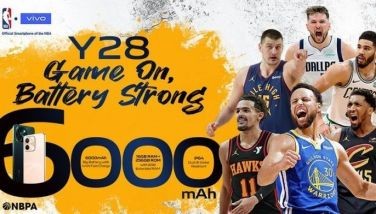The authority
Because his movies Kick Ass and Wanted got a sequel, so does Mark Millar.
But what’s even more astonishing about the explosive career of comic book writer Mark Millar’s is that some of his comic book stories are already being adapted for the big screen even before the comic books are published. His wallet is probably exploding as well.
After several years of writing the stories on Superman, Batman, the Flash and the Justice League for DC Comics and Avengers, Fanstastic Four, Wolverine and X-Men for Marvel Comics, Mark has taken the next step in comic book writing and embarked on creating several new comic book universes for his own company, Millarworld. Aside from Kick Ass and Wanted, these new comics include Superior and Supercrooks (with Pinoy collaborators Leinil Yu and Gerry Alanguilan), Nemesis and Secret Service.
In the second part of my interview with Scottish scribe Mark Millar, my fellow vegetarian shares why there is so much over-the-top violence in his work, what were his favorite (and not-so-favorite) works and his advice for aspiring Pinoy comic book writers.
PHILIPPINE STAR: The comic book writers from the United Kingdom are “superstars” — Alan Moore, Garth Ennis, Warren Ellis, Grant Morrison among them — because they bring a unique voice to the US comic book industry. Sometimes it appears as if you are outdoing the American writers. Just what is it in the water that makes your writing styles so compelling to read? Do you have a couple of muses chained up in your homes?
Mark Millar: I’ve got a theory. I think it’s no coincidence that somebody like Alfredo Alcala (RJ’s note: Filipino artist who migrated to the US in the Seventies. He drew Star Wars, Conan the Barbarian and inked Swamp Thing among others) breaks through from the Philippines and suddenly 20 other great artists from the Philippines break through as well. I think it just takes one person to do it and then a bunch of interested guys will say, “I can do that too!” Alan Moore broke into American comics from the UK to work for American publishers and inspired many others, myself included. If Alfredo Alcala and Tony de Zuniga (RJ’s note: Filipino artist who created Western gunslinger Jonah Hex) hadn’t cracked DC Comics in the Seventies, you probably wouldn’t have this wave of Filipino artists right now in American comics. Somebody has to be Neil Armstrong.
On top of walking on the moon, there’s a certain literary sensibility that I’ve only noticed among British writers which I don’t see among American writers. You trying to get all of us to eventually read Shakespeare?
There are different cultural sensibilities going on. UK comic book characters are very distinct from US comic book characters. In the UK, we’re very interested in violence and anarchism. For example, the two most popular comic book characters in the UK are Judge Dredd and Dennis the Menace, and both are very anarchic comic book strips. Judge Dredd is a superhero in a sense, but he solves problems by shooting people in the face. This couldn’t be more different than Batman. The Joker has killed thousands of people and Batman just puts bat-cuffs on him and brings him in prison. Dennis the Menace is a young anarchist, a kid who is always being spanked by his parents because he gets into trouble. In the US, they’re interested in obedience and good behavior as reward. The characters they like in the US are those who wear uniforms and uphold the status quo. Superman, for example, is an idealistic guy who wears a uniform and preserves the status quo. That’s why I think Americans like soldiers and cops, because they are almost like father figures. And their superheroes kind of carry that image through. In the UK, people are suspicious of guys in uniforms and are more likely to disobey than to obey them.
In the Philippines, we are scared of guys in uniform. Until we’ve made the proper payments.
Our (UK) perspective on heroes is, “Why are you dressed like a bat? That’s weird.” If a guy is dressed as a bat and beats people up, then we are suspicious of him. That’s the point of view from that informs our stories. In the US, their perspective on heroes is, “Of course he’s dressed like a bat and solving crimes (laughs).”
As opposed to other comic scribes who have had their comic books translated into movies, why do you think your particular stories have made a smoother (and box-office friendly) transition to the movies?
 His latest creator-owned comic, Superior, with Pinoy collaborators Leinil Yu and Gerry Alanguilan, will be brought to the big screen by producer Matthew Vaughn.
His latest creator-owned comic, Superior, with Pinoy collaborators Leinil Yu and Gerry Alanguilan, will be brought to the big screen by producer Matthew Vaughn. I think I have a realistic, easy-to-understand, cinematic style (to my writing). You can open one of my books and read it the whole way through and it will all make sense. Not everyone (who writes comic books) writes like that. So when the movie producers look at my work, they can see the movie. It’s like the storyboards are all already there.
Did you always intend your creator-owned comic book stories — like Kick Ass and Wanted — to be turned into movies?
Not at all! Look at the Wanted comic book — the lead character is a rapist. He’s absolutely horrible. The comic book Kick Ass opens with the lead character pleasuring himself and it’s got a little girl saying the worst swear word in the world as she cuts someone’s head off. I never thought that those stories would be made into movies, so I was more surprised than anyone when it did happen.
I’m sure our MTRCB was just as surprised as you. What do you think was your breakout comic work that defined your career as a comic book writer?
Definitely, The Authority (RJ’s note: The Authority, a comic published by DC Comics under an imprint called Wildstorm, featured a team of “realistic” superheroes who used Machiavellian tactics to “create a better world”). I even remember the exact date when everything completely changed for me — March 2000. Before then, no one was reading my stuff (laughs). I was doing some good work (DC Comics’ Aztek, The Ultimate Man, Swamp Thing and Superman Adventures) and it was quite frustrating because all the books I was working on were always on the verge of being cancelled. But The Authority was the first breakout comic book that I did where the sales went up. That was so exciting for me because I could pay my taxes now (laughs). Then once I had a little heat on the book, other editors wanted to work with me. As a result of The Authority, I was offered Ultimate X-Men and then eventually The Ultimates, which was my dream project (RJ’s note: The Ultimate X-Men and The Ultimates were updated versions of the X-Men and the Avengers to attract fresh new readers to comics in the Nineties)
I remember religiously following the previous writer on The Authority, Warren Ellis (RJ’s note: Warren Ellis’ creator-owned comic book Red has been adapted into a movie of the same name starring Bruce Willis) and wondered, who could possibly top Ellis’ swan song story about superheroes versus “god” — the hostile alien creator of the solar system.
(Laughs) And everybody was like, “What!?” The Superman Adventures guy? What a terrible choice.
I was living in the US at the time your run on The Authority came out and I remember thinking, “They allowed Millar to write about superheroes like this!?” I recall reading allegations that the publishers wanted you off the book because of the wide-scale violence depicted in the stories (i.e. buildings coming down) that was not politically correct in the wake of 9/11.
That’s technically not true. DC Comics had been giving me a hard time even before 9/11 because they wanted to “kill” The Authority book. Wildstorm (RJ’s note: Wildstorm was an imprint purchased by DC Comics that produced the WildCats, a superhero team that enjoyed its own cartoon TV series in the Nineties) was very supportive of the book. But The Authority not only featured superheroes that were cynical and swore and drank and had sex, but it also had a character that looked like Superman that was kissing a character that looked like Batman. Back then, DC Comics was very old school and they hated (these type of characters). But until people started talking about (the comic book), DC wasn’t aware that they were publishing it. Every month, every issue of The Authority went through two hours worth of corrections. In April 2000, DC didn’t want to publish it any more. They were trying to kill the book ever since I started working on it. It was death by a thousand cuts. So (writing for) Marvel Comics was an amazing relief after writing (The Authority) because at that time they had just been in bankruptcy so they were ready to take crazy gambles on anything.
And Marvel let you throw the dice with arguably their two biggest properties, the X-Men and The Ultimates (Avengers). Where do you get all these new ideas in an industry where almost every story has also been practically rehashed or regurgitated?
I’m just very clever (laughs). Remember in May 1938, Superman didn’t exist. The following month, June 1938, Superman existed. People were like, “Why didn’t we think of this?” Then a year later, Batman existed. A year after that, Wonder Woman existed. There was a time these characters weren’t comic books and somebody made them up. There’s no reason why we can’t just keep doing that. It’s funny because (the major publishers) keep going back to the “well.” For DC, they haven’t really created a lot of new characters since the Forties. They’ve just been updating their old characters (RJ’s note: DC Comics is the fictional home to Superman, Batman, Wonder Women, Flash, Green Lantern among others. They recently “updated” all of their characters in an initiative called “The New 52”). Marvel has only really created two new characters since the Sixties, Wolverine and the Punisher (RJ’s note: Marvel is the fictional home to Spider-Man, X-Men, Fantastic Four, Captain America and the Avengers among others). I think the comic book industry has to keep moving forward and keep on coming up with new stuff. I got into comic books to do the stuff that I loved as a kid. But now that I’m in the industry, what we need now is more (new creator-owned characters like) Superior, Supercrooks, Nemesis and Kick Ass. That’s what I love about this period of comic books right now, there are so many new creator-owned titles coming our right now (Walking Dead, America’s Got Powers, Saga).
We have a lot of great Filipino artists who have broken into the US comics scene. But how about our Filipino comic book writers? Talented writers like Budjette Tan (creator of Trese) and Arnold Arre (creator of Mythology Class) deserve to make it on the international stage.
Very simple. Almost no one will read your scripts because a script takes ages to read and it’s hard to visualize. And editors are lazy (laughs). The best thing to do is team up with an artist and do a six-page story or the first six pages of your story, have it lettered, then get the story up online and let people see it. Editors can tell inside of a few pages if someone’s good. But don’t self-publish because it’s too expensive. If you are a writer, I have a website — Millarworld.biz — where you can meet artists who can illustrate your stories. If you’re good, you’ll be fine. Obviously, there’s no conspiracy to keep good people out of the industry. The industry is desperate for new artists and writers all the time. But you have to be better than the guys they are hiring at the moment.
* * *
Thanks again to Miguel Ramos of National Book Store for arranging the interview.
For comments, suggestions or if you want to share your favorite Mark Millar stories, e-mail ledesma.rj@gmail.com or visit www.rjledesma.net.















